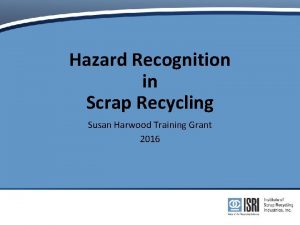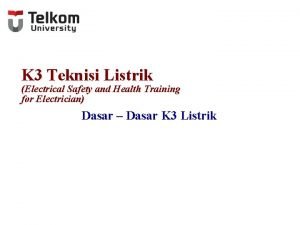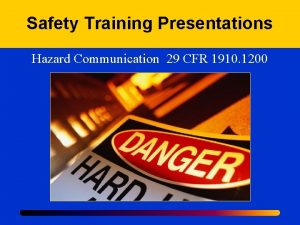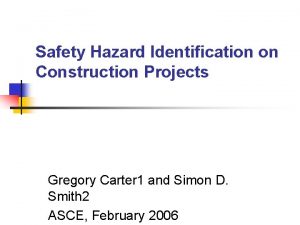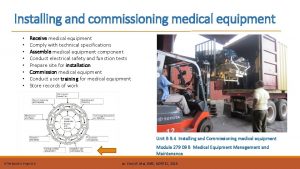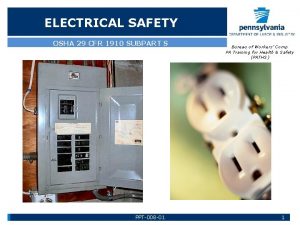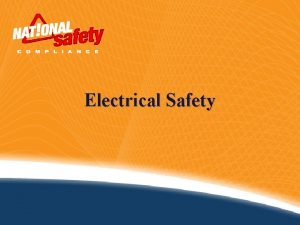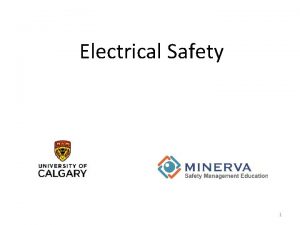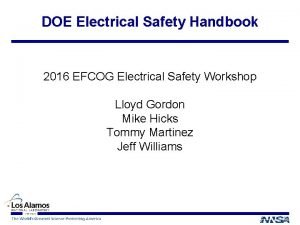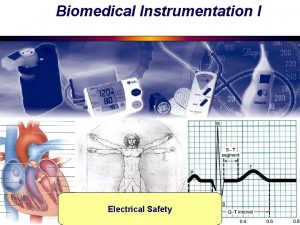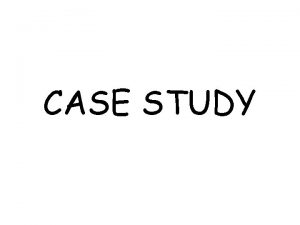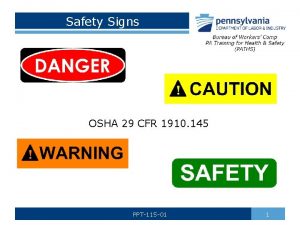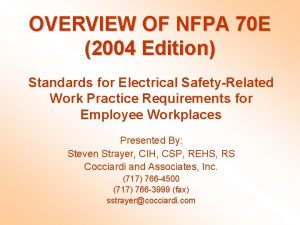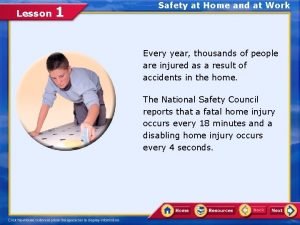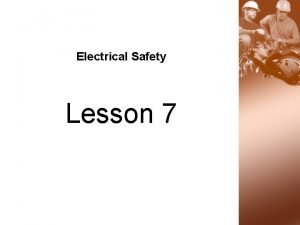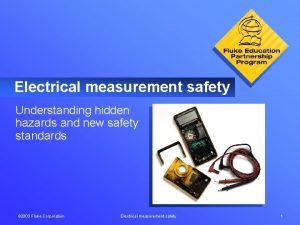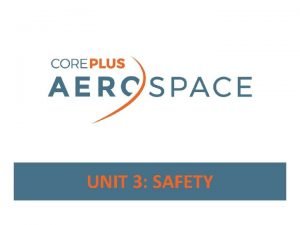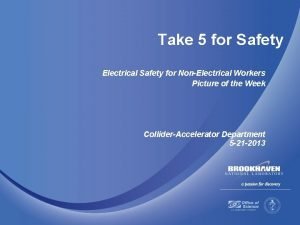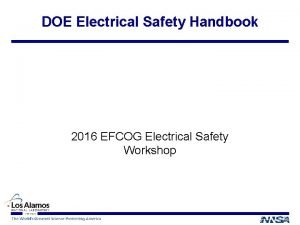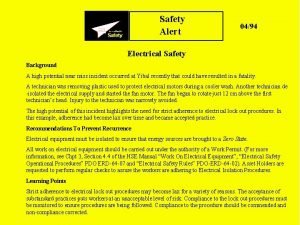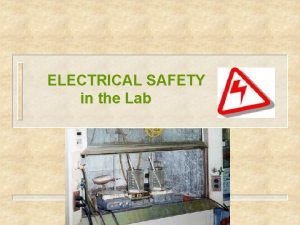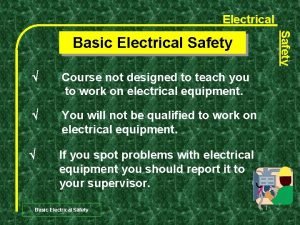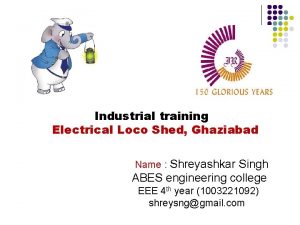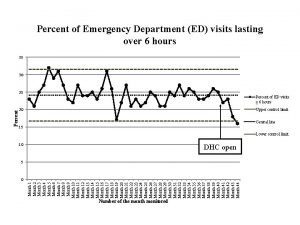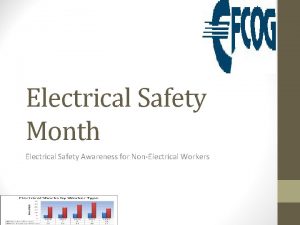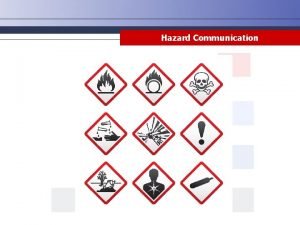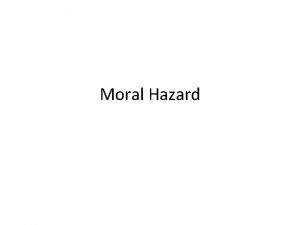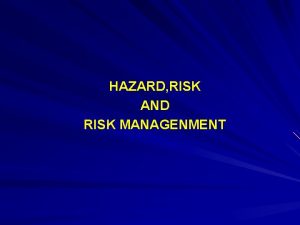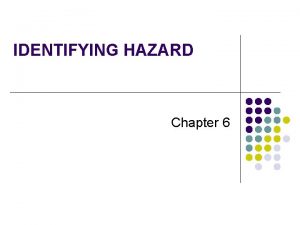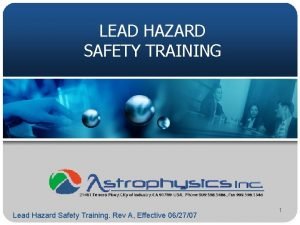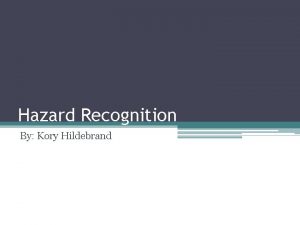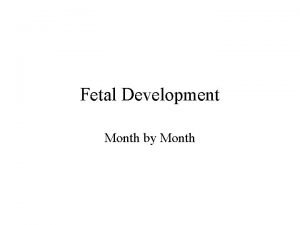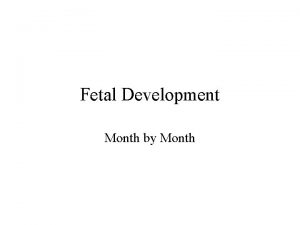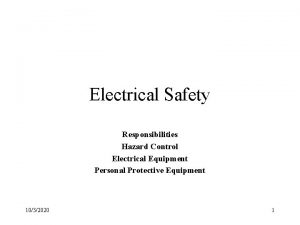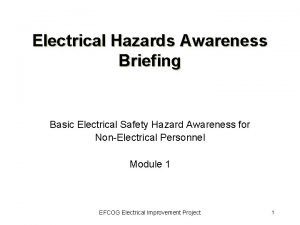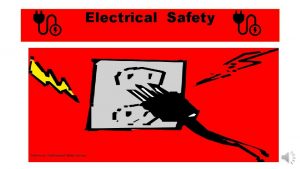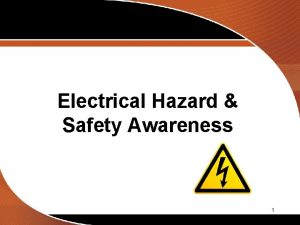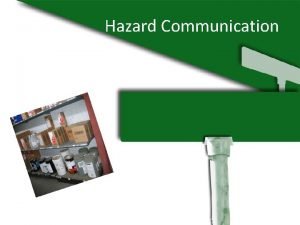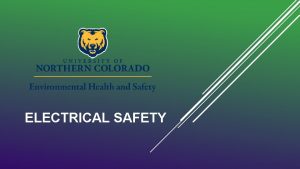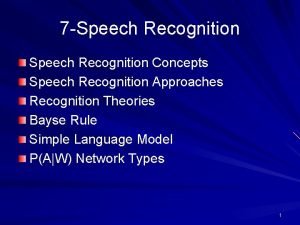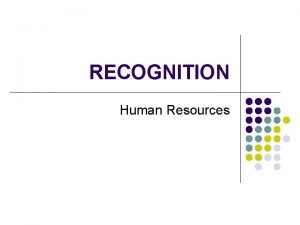Electrical Safety Month 2015 2 Electrical Hazard Recognition




































- Slides: 36

Electrical Safety Month 2015 2 – Electrical Hazard Recognition Techniques EFCOG Electrical Safety Subgroup May 2015

Objectives • Improve your ability to identify hazards • Discuss Fundamentals of Hazard Recognition • Discuss practical methods for use in the field to assist in identifying hazards

Principles of Hazard Recognition • Hazard recognition is a skill that requires training and persistence. • There is a best way to do every job – the efficient, high quality, cost effective and safe way. • Every organization needs a variety of hazard recognition techniques.

Methods to help Identify Hazards • Job Hazard Analysis • Pre Job Safety Analysis • Last Minute Safety Check • Work Permit, Energized Electrical Work Permit or Hot Work Permit • Demolition Planning (1926. 850 a) • PPE Hazard Assessment (1910. 132 d) • Equipment Inspections for Ladders, Tools, Welding Equipment, Cord Sets

The True Method for Controlling Hazards • Planning!!! • Plan every job • Every task • Every activity must be planned.

Why Do Injuries Happen? • Cannot be prevented (act of GOD) – very few workplace injuries fall in this category • Deliberate act or willfully hurting oneself – very few of these • Acceptable risks – very few • Failures in the management systems – 95% of injuries are due to this

What is Meant by Failures in the Management Systems? • Inadequate management leadership and action • Inadequate employee involvement in safety and health • Inadequate training and education • Inadequate purchasing controls • Inadequate rules, policies and procedures • Failure to hold others accountable • Failure to recognize hazards

Hazard Recognition • The Importance of Codes and Standards to Hazard Recognition • Standards give us: • • Explanations of Hazards Clues as to Where Hazards May Exists Control Measures If You Don’t Know the Rules and Hazards – ASK!!

Fundamentals of Hazard Recognition • Hazard recognition is a management and employee responsibility

Fundamentals of Hazard Recognition • Hazard recognition is a management and employee responsibility • Hazard recognition is a key element of “Doing the Job Right”

Fundamentals of Hazard Recognition • Hazard recognition is a management and employee responsibility • Hazard recognition is a key element of “Doing the Job Right” • Accidents are caused by both unsafe actions and unsafe conditions

Most Common Unsafe Conditions • Inadequate Guards and Devices • Hazardous Personal Attire (Hair, Jewelry, Clothes) • Poor Housekeeping • Inadequate Fall Protection • Projection and Impaling Hazards • Improper Placement and Storage • Congestion and Close Clearances • Poor Illumination and Loud Noise • Hazardous Atmospheres • Unidentified Chemicals

Most Common Unsafe Actions • Operating Equipment Without Authority • Taking an Unsafe Position • Failure to Make Secure • Being in the Line of Fire • Operating at an Unsafe Speed • Not Keeping Eyes on the Task • Overriding Safety Devices • Taking Shortcuts • Using Defective Tools and Equipment • Failure to Warn or Signal • Horseplay

Fundamentals of Hazard Recognition • Hazard recognition is a management and employee responsibility • Hazard recognition is a key element of “Doing the Job Right” • Accidents are caused by both unsafe actions and unsafe conditions • Every company needs a variety of hazard recognition techniques

Hazard Recognition Techniques • There must be a wide variety of hazard recognition techniques at every organization • There must be adequately trained personnel to recognize hazards • The hazard recognition management system must be effective and audited periodically • There must be some techniques that are easy to implement and use in the field

Three Opportunities to Recognize Hazards • Planning – Prior to Exposure • Auditing – During Exposure • Incident Investigation and Review – Post Exposure

Pre Exposure Techniques • • • Last Minute Safety Check Pre Job Safety Analysis Issuing Work Permits Pre-Use Analysis (New Equipment, New Chemicals) Blueprint Reviews S/H/E Project Reviews Management of Change Turnaround Planning Employee Suggestion Boxes Open Door Policies Safety by Design

During Exposure Techniques • Job Hazard Analysis • Hazops / What-If Analysis • Walkthrough Inspections and Audits • Equipment Inspections • Management System Audits • Perception Surveys • IH Surveys • Housekeeping Reviews • Documentation Audits

Post Exposure Techniques • Root Cause Analysis • Action Critiques such as Emergency Response, Rescues, New Process Startups • Demolition Audits • Documentation Audits • Safety and Health Policy Audits

Five Practical Hazard Recognition Techniques for Use in the Field

Five Practical Hazard Recognition Techniques for Use in the Field • Last Minute Safety Check

Last Minute Safety Check Every job, every task, every operation must be planned and rechecked One simple field technique is a short multi-step process based on the following 4 questions: 1. What am I about to do? 2. What do I need to do this job and how will I do it? 3. How could I get hurt? 4. What am I going to do to prevent injury?

Last Minute Safety Check Numerous Names for This Technique SCAN – Survey, Consider, Analyze, Notify HARM – Hazard Analysis and Risk Mitigation 360° – Bell Helicopter HARA – Hazard Analysis and Risk Assessment SARA – Safety Analysis Risk Assessment SLAM – Stop, Look, Analyze, Manage or Mitigate

Five Practical Hazard Recognition Techniques for Use in the Field • Last Minute Safety Check • Ten Second Drill

Ten Second Drill • Take 10 seconds to look at what is going on around you. • How will your task impact others or yourself?

Five Practical Hazard Recognition Techniques for Use in the Field • Last Minute Safety Check • Ten Second Drill • Out-of-View Observations

Out-of-View Observations • Many hazards lurk behind closed doors, in closets, in cabinets, in drawers. • It’s easy to spot issues within plain view. • Take the time to look in cabinets, drawers, lockers, and under work benches and tables for out-of-plain-view hazards

Five Practical Hazard Recognition Techniques for Use in the Field • Last Minute Safety Check • Ten Second Drill • Out-of-View Observations • Ask the Two Key Questions

The Two Key Questions of Hazard Recognition 1. Is there anything different?

First Key Question – Is there anything different? • Different based on your education, your life experiences, your expectations of the workplace. • When you see something different and you don’t know if a hazard exists, ask someone who would know.

The Two Key Questions of Hazard Recognition 1. Is there anything different? 2. Why not correct a hazard now before someone gets hurt?

Second Key Question – Why not correct a hazard now before someone gets hurt? • If someone gets hurt, would any changes be made to prevent recurrence? • If not, then the hazard is an acceptable risk. • If so, why not change the hazard now before someone is injured?

Five Practical Techniques for Hazard Recognition • Last Minute Safety Check • Ten Second Drill • Out-of-View Audits • The Key Questions of Hazard Recognition • Equipment Inspections

OSHA Inspections Requirements for General Industry and Construction • 250 General Industry Inspection Rules • 150 Construction Inspection Rules • Abrasive Wheels • Air Receivers… • Welding Machines • Wheel Rims

Summary • Hazard recognition is a skill that requires training and persistence • There is a best way to do every job – the efficient, high quality, cost effective and safe way • Every organization needs a variety of hazard recognition techniques

More Info This year’s Electrical Safety Month materials include an in depth look at how to recognize and avoid Electrical Hazards, techniques for hazard recognition, and risk assessment. Please review the materials, post them in your work place, and share them with others – and don’t keep this stuff at work – your families and friends also stand to gain from this info. Additionally, the Electrical Safety Foundation International (ESFi) has an excellent publication for Electrical Safety Month: Electrical Safety Illustrated Download the magazine – lots of very useful and relevant articles on general electrical safety for work and home – and many of the articles enhance the information you will find here on the Electrical Safety Month pages. And as always, contact your local site’s Electrical AHJ for additional information on electrical safety. THINK ELECTRICALLY SAFE!
 Month of nisan
Month of nisan Synodic month vs sidereal month
Synodic month vs sidereal month Hazard recognition quiz
Hazard recognition quiz Two main whmis 2015 hazard groups
Two main whmis 2015 hazard groups Potensi bahaya listrik (electrical hazard) adalah
Potensi bahaya listrik (electrical hazard) adalah The safest ladder to use around electricity is
The safest ladder to use around electricity is 29 cfr 1910 osha 178
29 cfr 1910 osha 178 Safety hazard identification on construction projects
Safety hazard identification on construction projects Touch current vs leakage current
Touch current vs leakage current What is the children’s safety on motorcycles act of 2015?
What is the children’s safety on motorcycles act of 2015? Electrical safety analyzer
Electrical safety analyzer Cfr 1910 subpart s
Cfr 1910 subpart s How electricity works
How electricity works Electrical safety introduction
Electrical safety introduction Doe electrical safety handbook
Doe electrical safety handbook Chassis leakage current
Chassis leakage current What three elements are required for all electric circuits
What three elements are required for all electric circuits Electrical safety case study answers
Electrical safety case study answers Osha safety signs and symbols
Osha safety signs and symbols Nfpa 70e 2004 standard for electrical safety
Nfpa 70e 2004 standard for electrical safety Lesson 1: electrical safety culture
Lesson 1: electrical safety culture Electrical safety worksheet answers
Electrical safety worksheet answers Fluke electrical measurement safety test answers
Fluke electrical measurement safety test answers Lesson 1: electrical safety culture
Lesson 1: electrical safety culture Take 5 electrical safety
Take 5 electrical safety Doe electrical safety handbook
Doe electrical safety handbook Electrical safety alert
Electrical safety alert Electrical lab safety
Electrical lab safety Basic electrical safety
Basic electrical safety Electrical safety office ghaziabad
Electrical safety office ghaziabad Which display mode is allowed for proper navigation?
Which display mode is allowed for proper navigation? Safety care certification
Safety care certification Personal safety vs process safety
Personal safety vs process safety Ind safety report
Ind safety report Basic safety orientation
Basic safety orientation 00101-15 basic safety
00101-15 basic safety Janvier month
Janvier month


